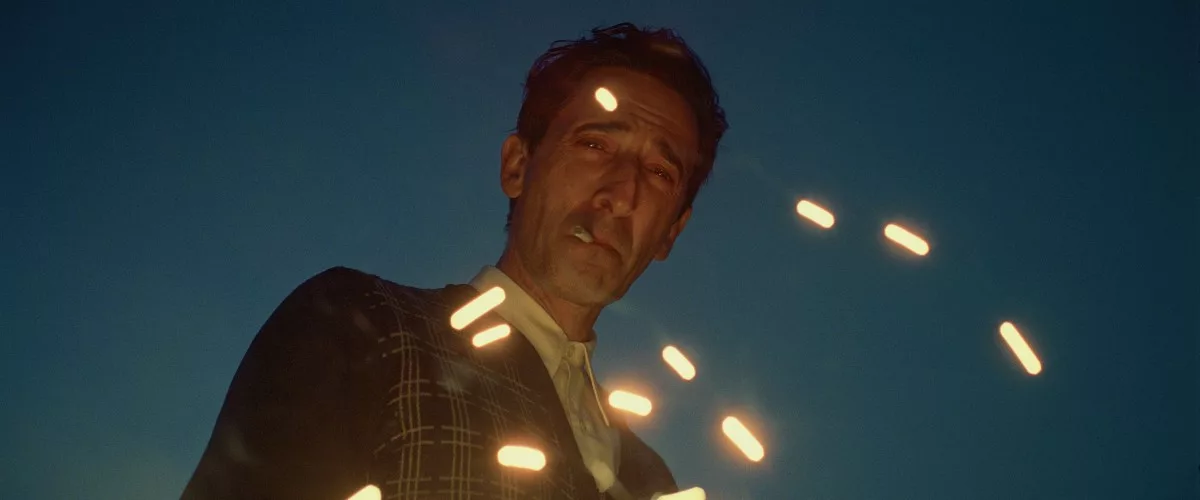
I have long maintained that you don’t need to see a film to assess its Oscar chances and that, in fact, seeing the film might actually cloud your judgement. (One should never let personal taste or gooey emotion get in the way of the joyless calculation that is Oscar prognostication.) So when I first heard about The Brutalist, Brady Corbet’s ambitious, three-and-half-hour epic about the mid-century American immigrant experience that received raves out of Cannes, I thought, “I smell an Oscar!”
It had all the hallmarks of an Oscar darling. Academy voters love epics, they love history, especially World War II—better still if the film is about the Holocaust. They love films about brilliant, tortured men. And if the film features a haunting, tour-de-force performance from its male lead? Start making room in that trophy case.
Now that I’ve seen The Brutalist, my opinion hasn’t really changed—I still think it’s going win. But it turns out the film is much weirder, more singular, more audacious than I ever expected it to be. For one thing, Corbet breaks his grand-scale film—shot in a stunning, mid-century hi-res technology called VistaVision—into small, sometimes shockingly intimate set pieces. Although it is never boring, its pace is defiantly unhurried. That haunted male lead, played by Adrien Brody? He happens to be a heroin addict, a snob, and a philanderer, among other things. The film is both better than I thought it would be, and less Oscar bait-y, if that makes any sense. It almost made me wonder: Have the Oscar voters seen it?
When we first encounter László Tóth (Brody), he is in the steerage compartment of a ship arriving at Ellis Island. He has broken his nose along the way—or so we’re told (with all due deference to the prodigious beak of Mr. Brody, it’s hard to tell)—which starts him on his path to heroin addiction. He is greeted by his cousin, Attila (Alessandro Nivola), who takes him home to live and work in his custom furniture shop, Miller and Sons, just outside of Philadelphia. (“Who’s Miller?” László asks. “I am,” Attila says, explaining that he Americanized his last name. He also invented make believe sons because Americans like “family businesses.”)
Miller and Sons sells sturdy, Shaker style furniture, which László regards with some disdain.
“What do you think?” Attila asks.
“Of the furniture?” sniffs László. “It’s not very beautiful.”
As we are soon to find out, before the war broke out and he was imprisoned in a concentration camp, László was a rising-star architect in Budapest, a progenitor of the Brutalist style. (The massive, minimalist structures represent permanence to László in a fragile world.) Now Attila has agreed to let him live in a spare room, adjacent to the workshop, as long as he helps out with the custom builds. Attila’s beautiful, gentile wife, Audrey (Emma Laird), isn’t super keen on this new tenant, and will ultimately be the thing that comes between the cousins. (Attila represents one choice available to the European immigrant Jew—assimilation as a survival tactic.)
László has a wife of his own, Erzsébet (Felicity Jones), whom he assumed died in the war. When Attila tells him that she’s alive but stuck in Europe with László’s niece (Raffey Cassidy), László collapses in relief and joy. But getting Jewish refugees to the U.S. is challenging, bordering on impossible. So he must carry on with the real possibility he’ll never see her again.
After his falling out with Attila, László takes a menial job with a construction crew where he is reintroduced to captain of industry Harrison Van Buren (Guy Pearce, never better). They had met before, when László and Attila had built him a custom library, a surprise gift from his son (Joe Alwyn). Van Buren hated the library, designed by László with remarkable retractable shelves, and threw László and Attila out of the house. (He was also bothered that László had brought a good friend to help with the construction who happened to be Black.)
Now he has returned to László, a bit sheepishly. He has discovered that László was, in fact, a famous architect—a man of great distinction. Van Buren would never admit that he didn’t like or understand the library—he protests that his mother was sick and dying and he was too upset to fully appreciate it, but he wants to hire László for a job. He’ll be building a massive community center/gym/chapel on his property, allegedly in honor of his late mother but actually a monument to himself, and he wants László to design it. And thus begins the precarious relationship between the two men. Van Buren claims that he is intellectually stimulated by his talks with László, but he’s also quick to denigrate his tattered clothes and broken English. He’s seething with jealousy over László’s brilliance, but he’s repulsed by him, as well. And he’s a man who like to lord his wealth and power over everyone who meets. As you can guess, things will not go smoothly between them.
Eventually, Van Buren puts László in touch with a lawyer who can arrange to bring Erzsébet and his niece to Pennsylvania. And that’s the end of the first half. Yes, there’s an intermission in this three-and-a-half-hour film, which I welcomed (and I didn’t even need to pee). It’s nice to be able exhale and gather your thoughts a bit before the second half begins.
The second half focuses on László’s relationship with Erzsébet, strained for a variety of reasons, and the various roadblocks he encounters building Van Buren’s massive vanity project. (Art and commerce have never made for good bedfellows—and when you throw in László’s status as an enigmatic Jewish outsider, things are further complicated.)
The malevolence of both Van Buren and his feckless son comes into high relief in the second half—perhaps a bit too unsubtly.
The film’s epilogue, set in 1980, is another audacious choice as László, now an old man, doesn’t even speak in it. But it’s there where we come to understand the particular choices László made in his creation of Van Buren’s massive center. It’s not a surprise ending, per se, but one that adds a layer of depth and poignancy to all we’ve just seen.
The Brutalist isn’t just the front runner for Best Picture; Adrien Brody will likely get an Oscar for playing László, his second time for depicting a Holocaust victim. Look, the guy has a face built for tragedy—expressive and searching and gaunt, like a hollowed out Buster Keaton. And he’s captivating here, depicting all of László’s contradictions—his vanity, his brilliance, his desperation.
I’m not quite prepared to call The Brutalist a great American masterpiece just yet—I’ll need to see it a couple more times to make that call—but it is quite extraordinary. A deeply personal story told on a grand scale. A story about American monsters and American heroes—and how those lines can sometimes blur. If it does win Best Picture, the voters will have accidentally gotten it right.
